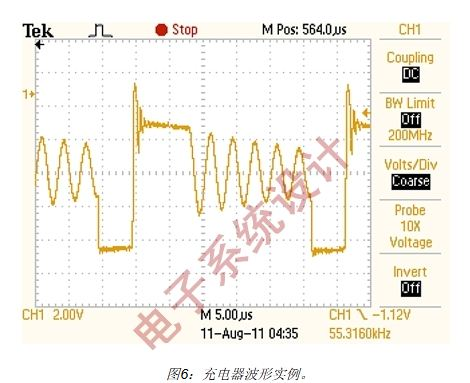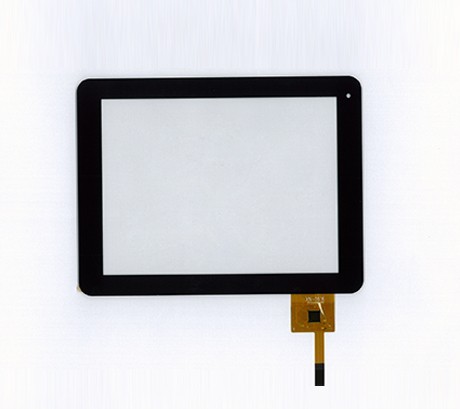How to solve the electromagnetic interference problem of small and medium size touch screen
How to solve the electromagnetic interference problem of small and medium size touch screen
Charger interference
Another potential source of touchscreen interference is the switching power supply of the mains-powered phone charger. Interference is coupled to the touch screen through fingers, as shown in Figure 5. Small cell phone chargers usually have AC line and neutral inputs, but no ground connection. The charger is safety isolated so there is no DC connection between the mains input and the charger secondary. However, this still creates capacitive coupling through the switching power supply isolation transformer. Charger interference creates a return path through a finger touching the screen.

Note: In this context, charger disturbance refers to the applied voltage of the device with respect to ground. This interference may be described as "common mode" interference due to its equivalence at DC power and DC ground. The power switching noise generated between the DC power output of the charger and the DC ground may affect the normal operation of the touch screen if it is not filtered out sufficiently. This Power Supply Rejection Ratio (PSRR) issue is another issue not discussed in this article.
Shenzhen Hongjia Technology Co., Ltd. specializes in the development and manufacture of 1.14-inch-10.1-inch capacitive touch screens and resistive touch screens, which can be customized according to customer requirements, including changing the touch screen cover glass size and glass material, touch screen cable, touch screen driver IC, etc., can provide OCA full bonding process and frame bonding process, the touch screen produced by our company has good anti-interference performance, high reliability, good sensitivity, long life and durability.
Charger coupling impedance
Charger switching disturbances are coupled through transformer primary-secondary leakage capacitance (approximately 20pF). This weak capacitive coupling effect can be compensated by the parasitic shunt capacitance that appears in the relatively distributed ground of the charger cable and the powered device itself. When the device is picked up, the shunt capacitance will increase, which is usually enough to eliminate the charger switching interference, so that the interference does not affect the touch operation. One of the worst-case interferences from the charger occurs when the portable device is connected to the charger and placed on a table with the operator's fingers only in contact with the touchscreen.
Charger switch interference component
A typical mobile phone charger uses a flyback circuit topology. The interference waveform generated by this kind of charger is more complex and varies greatly with different chargers, depending on the circuit details and output voltage control strategy. Interference amplitudes can also vary widely, depending on the design effort and unit cost invested by the manufacturer in the switching transformer shield. Typical parameters include:
Waveforms: Including complex PWM square waves and LC ringing waveforms. Frequency: 40~150kHz under rated load, when the load is very light, the pulse frequency or skip cycle operation drops below 2kHz. Voltage: up to half of the peak voltage of the power supply =Vrms/√2.
Interference component of charger power supply
On the front end of the charger, the AC mains voltage is rectified to generate the charger high voltage rail. In this way, the switching voltage component of the charger is superimposed on a sine wave of half the supply voltage. Similar to switching interference, this power supply voltage is also coupled through a switching isolation transformer. At 50Hz or 60Hz, the frequency of this component is much lower than the switching frequency, so its effective coupling impedance is correspondingly higher. The severity of supply voltage disturbances depends on the characteristics of the parallel impedance to ground and also on the sensitivity of the touch screen controller to low frequencies.

Special case of mains interference: 3-pin plug without ground
Power adapters with higher power ratings (such as laptop AC adapters) may be equipped with a 3-pin AC power plug. In order to suppress EMI at the output, the charger may internally connect the ground pin of the main power supply to the DC ground of the output. This type of charger usually connects Y capacitors between the hot and neutral wires and ground to suppress conducted EMI from the power line. Assuming an intentional ground connection exists, this type of adapter will not interfere with powered PCs and USB-connected portable touchscreen devices. The dashed box in Figure 5 illustrates this configuration.
For PCs and their USB-connected portable touchscreen devices, a special case of charger interference occurs if a PC charger with a 3-pin power input is plugged into a power outlet that has no ground connection. The Y capacitor couples the AC power to the DC ground output. A relatively large Y capacitor value couples the supply voltage very efficiently, which allows large supply frequency voltages to be coupled through a finger on the touch screen with relatively low impedance.

 English
English Español
Español Português
Português русский
русский Français
Français 日本語
日本語 Deutsch
Deutsch tiếng Việt
tiếng Việt Italiano
Italiano Nederlands
Nederlands ภาษาไทย
ภาษาไทย Polski
Polski 한국어
한국어 Svenska
Svenska magyar
magyar Malay
Malay বাংলা ভাষার
বাংলা ভাষার Dansk
Dansk Suomi
Suomi हिन्दी
हिन्दी


